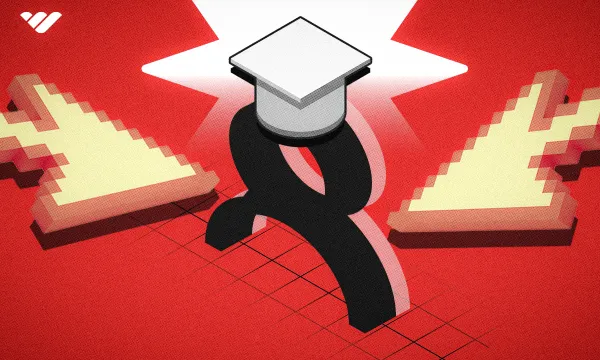It's no secret that jobs in tech are often the ones that make the most money. They're also among the ones that are the most future-proof. But what if you're not quite ready to commit to a full-time job?
In that case, you need a side gig, and there's no better category than tech side hustles. There are plenty of options, so you can get yourself a gig that pays well and doesn't eat into your free time. Getting started only takes a few minutes if you use Whop.
Sounds good, doesn't it? With the right gig and the right platform to connect you with your customers, you'll be in side hustle heaven. Luckily for you, this article is going to introduce you to the 15 greatest side hustles.
Could You Take On a Tech Side Hustle?
You absolutely can take on a tech side hustle, and you don't even need to be one of those tech-wizard-hacker types we see in movies. You just need a bit of determination, both to use your skills to your advantage and to become an entrepreneur.
It's all about finding the right gig for you, which we'll discuss below. First, let's take a look at the four things that will help you tremendously as you set off on your tech hustle journey.
Time management
Organizing your time is how you spend less time overall on your side hustle. If time management doesn't come easily to you, there are some ways to hack your own brain, so to speak. Here are some techniques I've tried myself:
- With the Pomodoro Technique, you pick a task and set a time for 25 minutes. Once it rings, take a five-minute break.
- The Eisenhower Matrix is all about prioritization. Organize your jobs or work-related tasks into a four-quadrant table. Each quadrant is an intersection of "important" and "urgent." Start working on the ones that fall under the important and urgent quadrant first, then expand out.
- Now we're gonna Eat that Frog. Don't worry, no amphibians are harmed. For this one, you just start by figuring out what your hardest task is and jumping on that one first.
- Time blocking is exactly what it says on the box. Figure out how much time you want to spend on your side hustle and then list the tasks you need to accomplish. Devote a specific chunk of time to each task, and stick with that.
- The Rapid Planning Method is one of the hack-iest brain hacks because it's all about training yourself to focus. Write down all the things you need to get done and then group them by similarities.
- The last suggestion we have is to consider the 80/20 Rule. This one comes from an Italian economist who had the idea that 20% of actions are responsible for 80% of the outcomes. This one is all about prioritization, choosing which tasks will have the biggest impact, and then doing those first.
Skill development
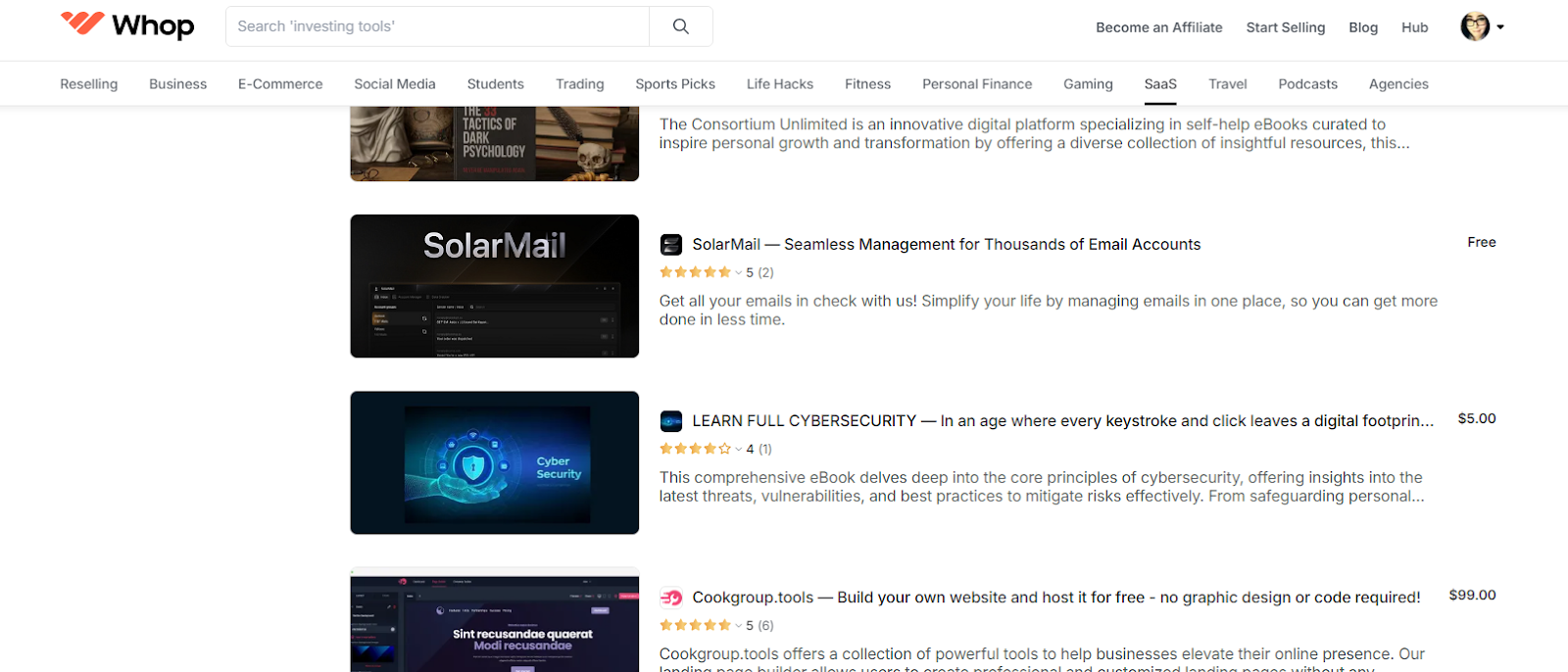
Working in tech, developing your skills is something you'll need to keep in mind forever. This sounds like a lot, but it doesn't have to be. A lot of continued education can be found in the job itself, as you learn how to navigate issues that come up and troubleshoot. Just don't be afraid of facing a problem head-on and learning your way through it.
You can also consider buying a course or two to refine your skills.
Networking
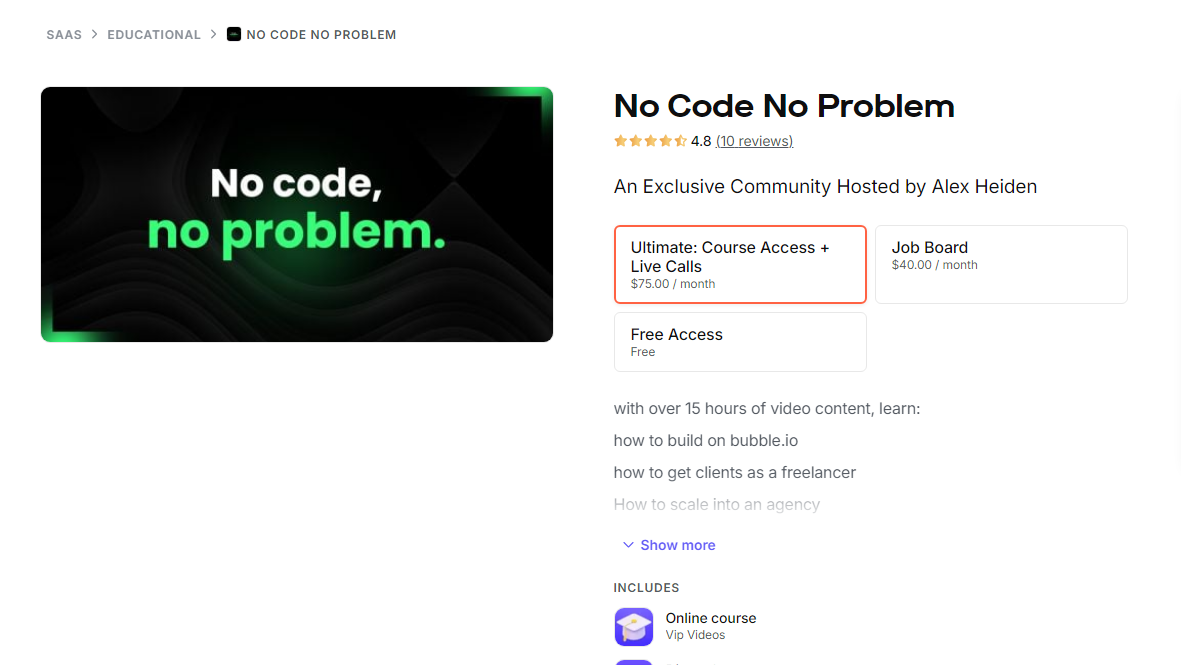
Networking is everything. Even as a beginner with your side hustle, you can network by joining communities made for people like you.
Exchanging ideas with other entrepreneurs is invaluable, and Whop is a great place to start. For instance, No Code No Problem on Whop is a community made by Alex Heiden, a B2B SaaS expert. Once you join, you can interact with others and also get useful ideas on SaaS or pro tips on getting clients as a freelancer.
Branding and marketing
Marketing goes hand in hand with networking. You can't get clients if the clients don't know that you exist. You don't have to have a huge initial marketing budget, either. It makes more sense to invest in your marketing as your profits roll in, but here are some low-cost methods to get the word out.
- Social media
- Blogs
- SEO
- Online ads
- Newsletters (which you can also make money with separately)
- Community engagement
The Best Tech Side Hustles that Can Earn You Some Serious Cash
Okay, now we're onto the good stuff. Here are our picks for 15 side hustles you can use to pad out your bank account without being chained to your desk.
1. Web design

As a web designer, your job is to take care of the visual part of web development. While it's possible to make money without a website, most companies prefer to have one, which is why this is such a great side hustle. Most freelance web designers can pull in between $30 and $100 per hour, and if you work for yourself, you set your own rates.
Here are some of the other skills you'll need as a web designer:
- HTML and CSS
- Responsive design
- JavaScript and JS frameworks, such as React.js, Vue.js, and Angular
- Design tools like Adobe XD, Figma, Sketch, or Photoshop
- User experience (UX) and user interface (UI)
The stronger your portfolio of examples is, the more you can charge. If you're starting out and don't have any examples, you can make a mockup to show off what you can do or you can volunteer to make a website pro bono if the brand/company allows you to use it as an example.
2. Copywriting

If your experience lies at the intersection of writing and marketing, then you can look into copywriting. Freelance copywriters can earn between $30 and $100 per hour.
One of the best things about being a copywriter is that many are completely self-taught. Having some formal education can be nice, but truthfully, most people won't care as long as your writing does the job.
Here are the strengths that will help you become a copywriter:
- Concise, engaging writing style
- Marketing skills and the ability to convert and sell
- SEO, including keyword research tools like SEMrush, Ahrefs, and Moz
- Competitor analysis
- On-page SEO
- A/B testing
- Strong research skills
As a copywriter, you can work with clients over Whop by sending them handy checkout links. Once you're a pro, you can set up your private community, as Kaleigh Moore did, and make money by teaching others about the art of copywriting!
3. Technical writing
If you want a writing-based side hustle but aren't really interested in playing up the marketing angle, check out technical writing. This is all about taking a complicated subject and breaking it down so that anyone can understand it. Freelance technical writers are often paid per project, and depending on size and complexity, you could easily earn hundreds of dollars.
As a technical writer, you'll need:
- You need to be able to break down complex subjects into something easy to follow, even for non-technical audiences
- An understanding of the niche. Technical writing fields include areas like medical devices, engineering, software development, etc.
- The ability to create documentation from scratch, including version control on tools like Git and GitHub or DITA, as well as Swagger, OpenAPI, and Postman
- Knowledge of crucial software, including Microsoft Visio, Lucidchart, InDesign, and content management tools
4. Coding
Knowing how to code and understanding programming languages can open up a lot of doors. This is a flexible skill set that you can apply to a lot of different opportunities—and make a lot of money from. Freelance programmers make up to $100 an hour, but if you have lots of expertise, you can score juicy retainers and make way more than that.
Here are some of the most common programming languages and frameworks:
- JavaScript
- Python
- HTML/CSS
- SQL
- Java
- R
- Vue.js
- React.js
- Angular
- PHP
- C#
- Swift
- Go
- Kotlin
- Ruby on Rails
- Django/Flask
- Node.js
- Rust
As a freelance programmer, you can work with clients directly or as part of a software engineering team on monthly contracts. Joining a programming Discord is a good place to start.
5. Video editing
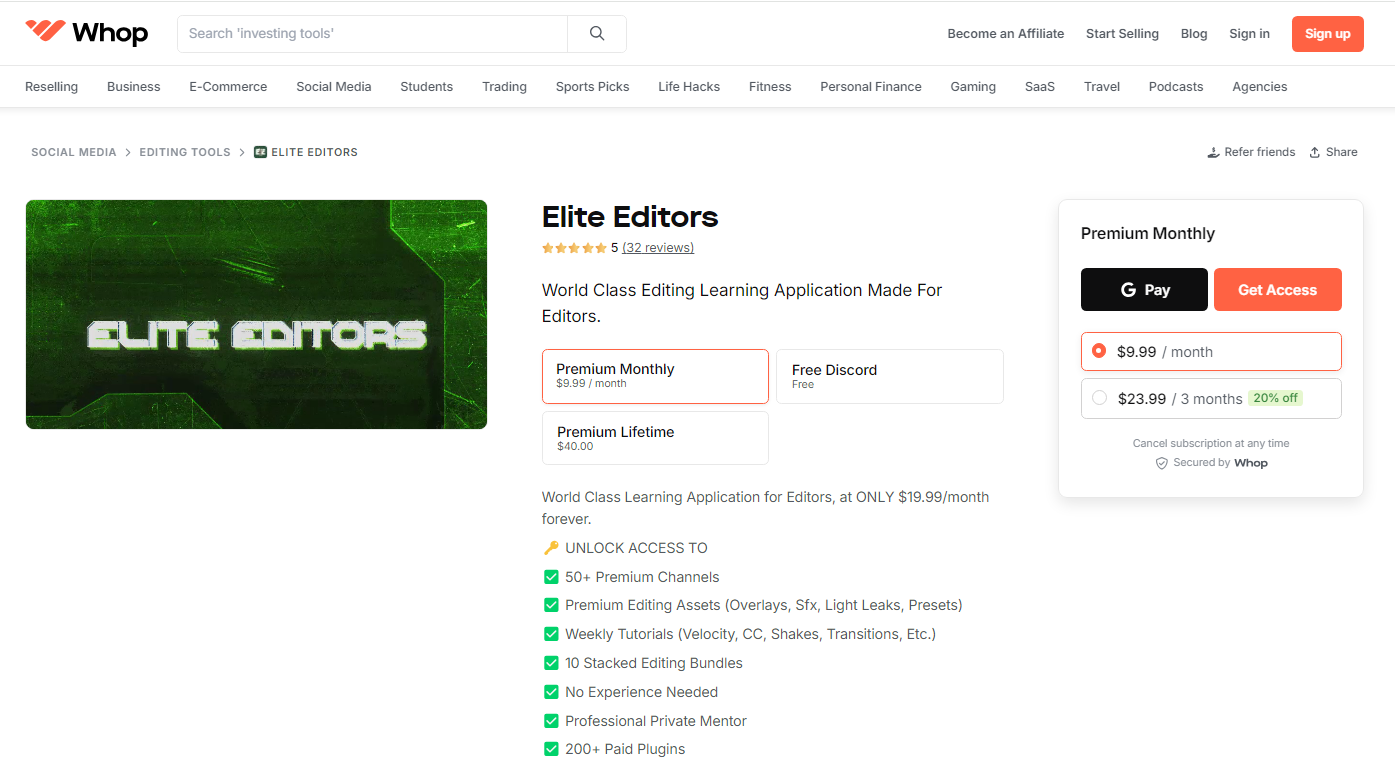
With the surge of people who want to be content creators for a living, editing skills can be put to work in more ways than ever before.
That doesn't mean you'll necessarily make the most money editing someone's Sephora haul or condensing a video game play through, but it's definitely an option. Video editors can make between $25 and $75 an hour, so having a good reel to show potential clients gives you leverage to ask for more.
As a video editor, here are some of the things you should know how to do:
- Edit. Obviously. You should be very familiar with programs like Adobe Premiere Pro, Final Cut Pro X, Adobe After Effects, DaVinci Resolve, Avid Media Composer, Sony Vegas Pro, and iMovie.
- More than just editing, you need to be able to use that skill to tell a story. Crafting a narrative that viewers don't want to turn off is necessary.
- Understand aesthetics. Again, technical knowledge of how to put something together only goes so far; you also need to know what color grading fits the tone your client wants, how to utilize transitions, and generally how to bridge the gap between two-dimensional media and emotional resonance.
To learn more about video editing, Elite Editors on Whop is a good place to start.
6. SEO consulting
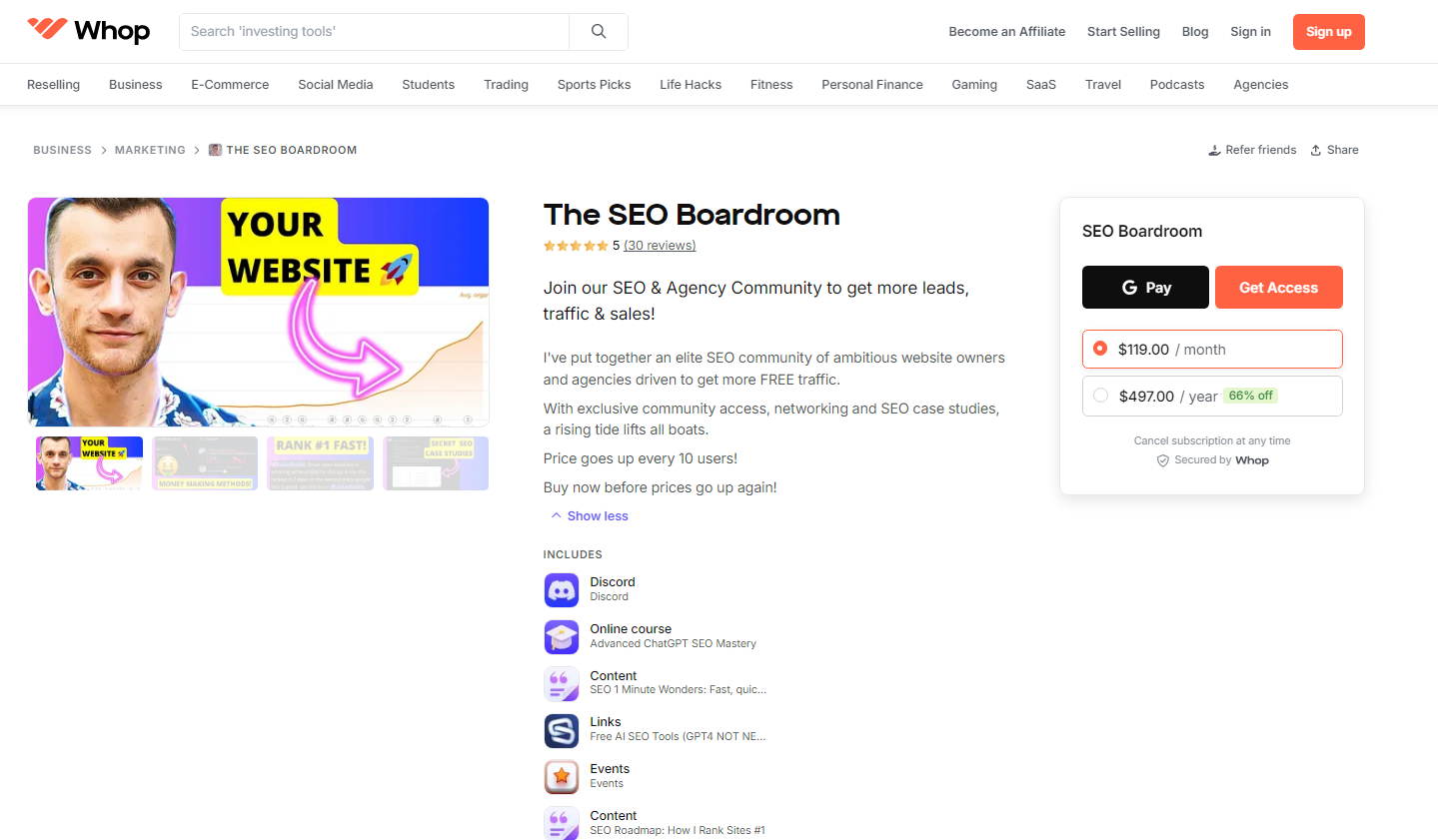
Today's modern internet is all about buying and selling, and brands want their product or their website to be the first thing a customer sees when searching online. Knowing how to wield the magic of search engine optimization can see you to a nice hourly rate of between $50 and $125.
Here's what an SEO consultant primarily does:
- Keyword research
- On-page optimization
- Technical SEO
- Content strategy
- Link building
- Analytics and reporting
- Competitor analysis
The SEO Boardroom on Whop is a fantastic place to start if you want to learn from experts and hang out with other SEO fanatics like you.
7. Prompt engineering
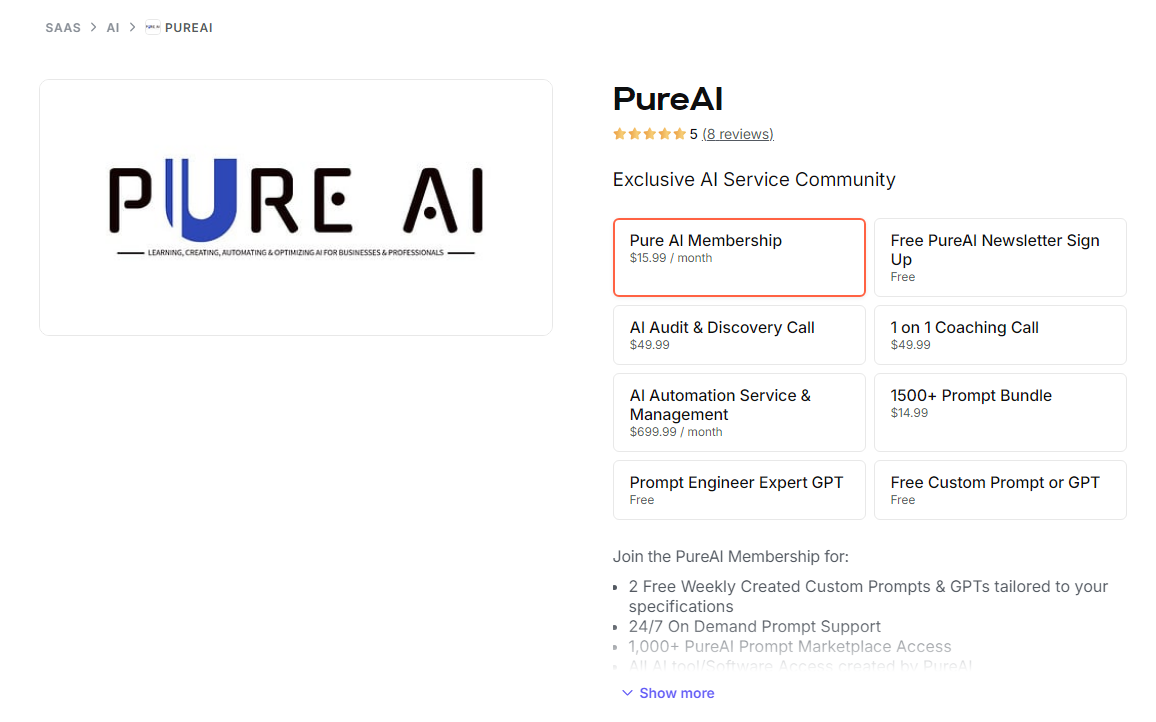
Prompt engineering is all about designing and refining instructions for generative AI models. Using the right prompts with chatbots like ChatGPT, Grok, Gemini, and Microsoft Copilot turns their generic drivel into something super useful. Hourly pay for prompt engineers ranges between $25 and $75 an hour.
These are the skills a prompt engineer should bring to the table:
- Knowledge of various AI models and chatbots
- An understanding of natural language processing (NLP) concepts like tokenization and embeddings
- A knack for experimentation and iteration—some prompts may take hours to craft until you achieve the desired effect
- Strong problem-solving skills
8. Tech support
As long as there is tech, there will be people who need help understanding or operating it. Tech support pros can make between $20 and $50 an hour, but it mostly depends on what kind of tech support you're offering and what kind of certifications you have.
Tech support is a perpetually growing field, and according to the Bureau of Labor Statistics, the trajectory is decidedly upward. BLS puts it at a 5% growth rate over the next six years.
Doing tech support as a side hustle can be done in two ways. You can make your own whop and let your clients book one-on-one calls with you to request help via tools like TeamViewer—that's a B2C kind of business. Alternatively, work with companies who need freelance tech support in a B2B manner.
9. White-label software
If you're a software engineer, here's your time to shine. Being a white-label software developer means that you design software and then sell it to a company. The company then rebrands the software themselves and offers it for sale.
You can pick this up as a side gig no matter if you're a front-end, back-end, or full-stack dev. Each client will need to be individually negotiated, but it's well within your rights to ask for the hourly fee (which comes to an average of $47/hour across the field) plus a percentage of sales.
Here are some tips for trying to make it as a freelancer with white-label software development:
- Pick a niche. This could be something like ecommerce platforms, CMR systems, etc. You can become an expert at specific kinds of software if you hone in on work to build a strong portfolio showing your skills.
- Speaking of: build your portfolio. The way to get a client interested is to have examples ready to show them.
- As a B2B venture, it's important to keep your customers happy and offer robust support even after you've built and sold the tool.
10. Web development
Experienced web developers top this list in terms of best-paying side hustles, making up to $150 an hour. This is obviously dependent on the complexity of the project and how much skill and experience you have, but it's still worth considering if you feel like you'd be a good fit.
Remember: Even if you don't want to become a self-taught software engineer, you can learn to make websites with platforms like WordPress, Wix, or Squarespace and offer them to your clients.
11. App development
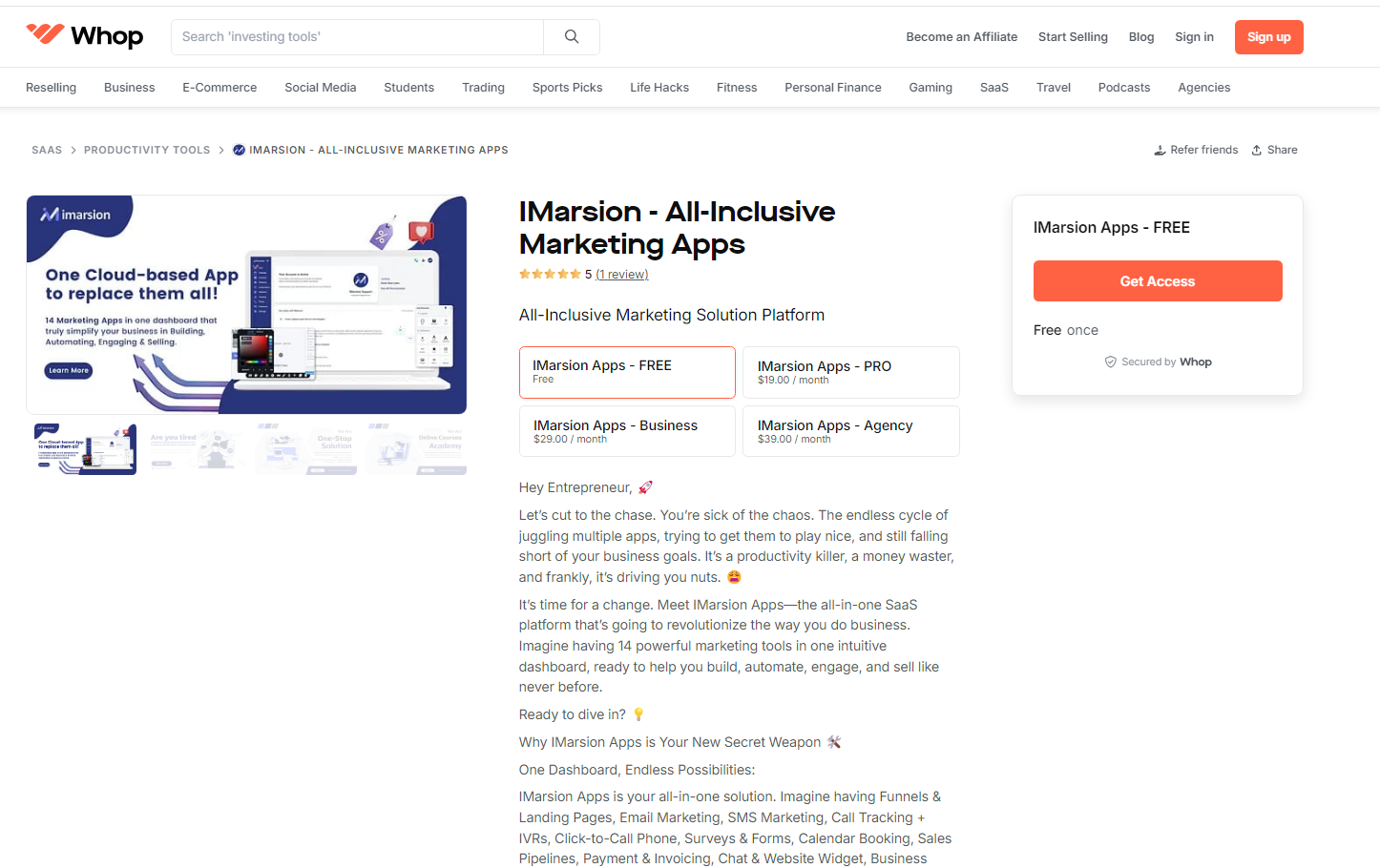
App development is right up there with web development in terms of potential pay per hour. Some of the skills needed overlap, but some don't. To stand out as a web developer, make sure you have some working knowledge of these skills and languages:
- Swift
- Kotlin
- Java
- JavaScript
- Angular
- Vue.js
- Node.js
- React Native
- Flutter
- Xamarin
- Mobile UI/UX design
- Third-party/API integration
- Version control
- Testing and debugging
- Database management
With app development, you can either work with a client directly or you can white-label your app.
12. Quality assurance testing (QA)
If you're patient, working in QA can be a good side gig—and it's always in demand. Rates for this type of hustle range from $20 all the way up to $75 and beyond for complex projects.
Depending on your level of expertise, you may be tackling:
- Beginner-level QA: manual testing, regression testing, maintaining documentation
- Intermediate level QA: automation testing, test planning and design, exploratory testing, API testing
- Specialized QA testing includes: developing automation frameworks, security testing, performance engineering, machine learning testing
These are not complete lists, since there are a lot of different niches within quality assurance. If you have what it takes to tackle any of those projects, then consider your side hustle on lock.
13. Social media management
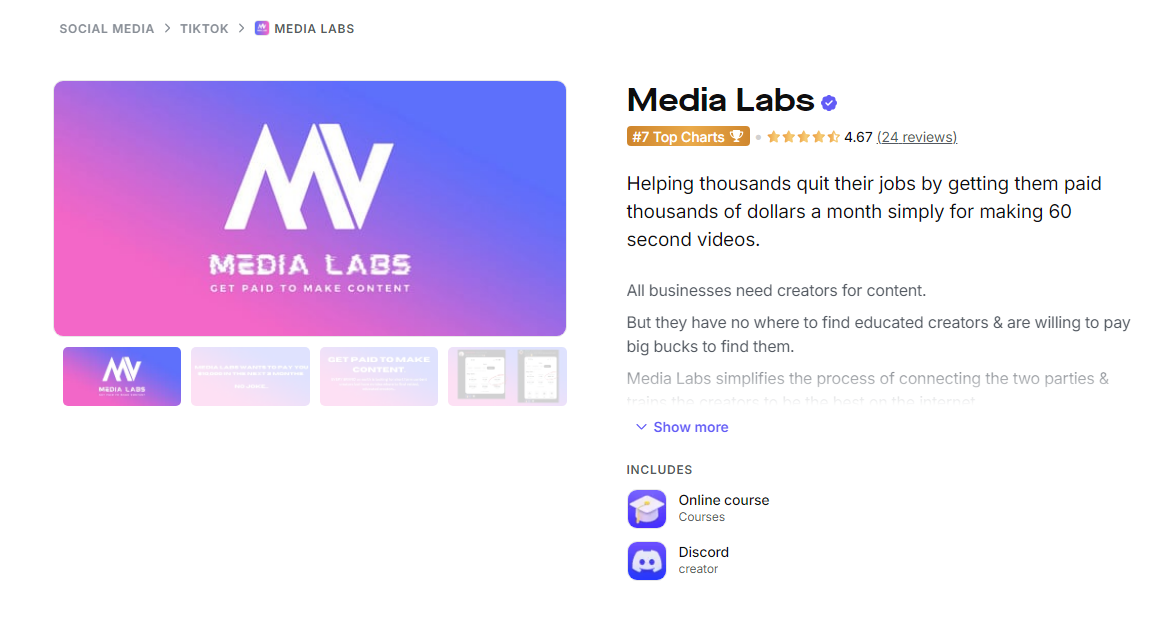
The nice thing about social media is that even if you've never managed it for a business, you probably already know something about it. TikTok, X, Facebook, Snapchat—most of us know all about the endless scrolling that takes place on these platforms.
Spinning that into a side hustle just involves getting to know the brand and marketing specific aspects of the platforms. Companies are willing to pay good money (between $25 and $75 an hour) to people who know how to use social media to grow follower counts, increase engagement, or drive sales.
Aside from a touch of SEO and copywriting, here are some of the programs a knowledgeable social media manager will be familiar with:
- Hootsuite
- Buffer
- Sprout Social
- Canva
- Adobe Spark
- Google Analytics
- Socialbakers
- Platform-specific analytics
- Brandwatch
- Mention
- BuzzSumo
- Discord
- SEMrush
- Ahrefs
- Moz
14. Tech consulting
Consulting is one of the most time-flexible remote side hustles you can get involved in. It requires less hands-on involvement than development or even quality assurance testing, but you can still offer the valuable advice that brands are always after.
This is also one of the best-paying side hustles, with consultants making up to $300 an hour.
Here are some of the most sought-after types of tech consulting:
- IT infrastructure
- Software implementation
- Cloud computing
- Data analytics
- Digital transformation
- Tech startup
- Ecommerce
- DevOps
- Telecommunications
- AI and machine learning
- Blockchain
- Technology strategy
Whop is the ideal platform to start building your consulting business. Through Whop, you can connect with clients via chat, forums, or video calls, and getting started only takes a few minutes.
15. Cybersecurity consulting
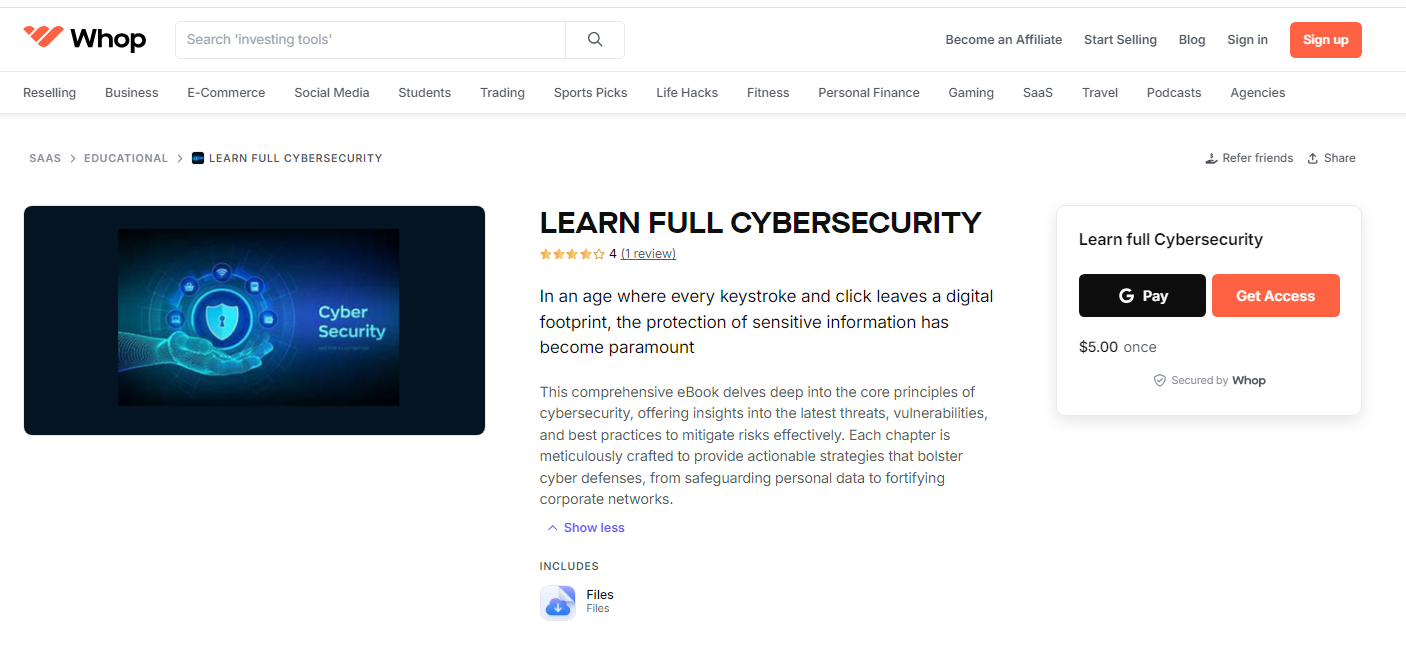
Cybersecurity consulting is a branch of tech consulting but one that requires such specialized expertise that it gets its own spot on the list. Cybersecurity is critical for businesses that don't want to get exploited, and they're willing to pay for the comfort and safety.
Here are some of the ways you can do that:
- Risk assessment
- Security audits
- Penetration testing
- Incident response planning
- Security architecture
- Training programs for staff
- Policy development
As a consultant, what you'll be doing is helping companies or brands protect their digital assets and comply with regulations. Entry-level cybersecurity experts can earn up to $75 an hour, with senior-level specialized knowledge pulling in upwards of $300 an hour.
Why Side Hustles in Tech Pay So Well
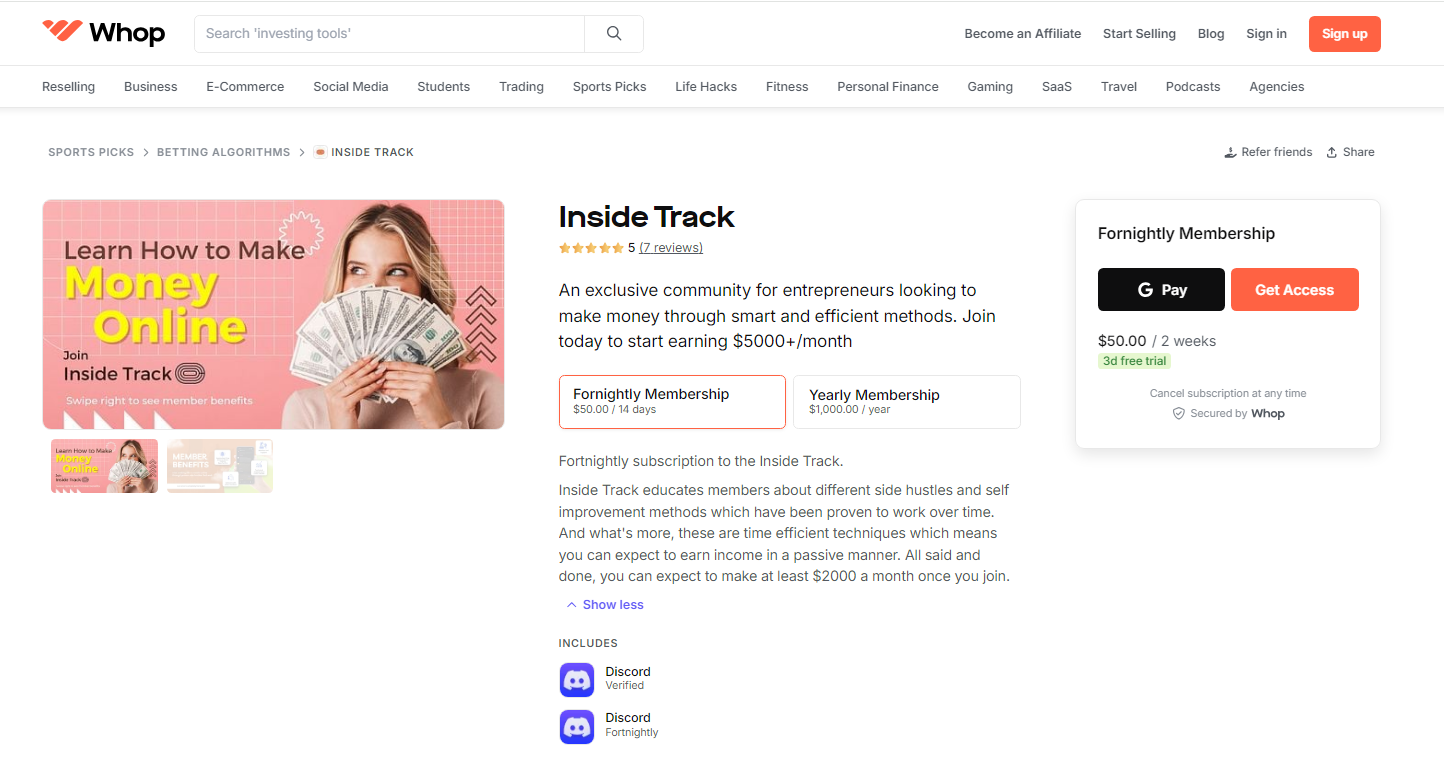
I know what you must be thinking. Every single job on this list is paying really well. Why is that? It's simple: tech skills are in constant demand.
Even with many people trying to learn programming or prompt engineers jumping on the rising AI trend, there still aren't enough professionals to meet the need for tech-savvy freelancers. And yes, I mean freelancers, because many companies these days prefer to work with an entrepreneur rather than a full-time employee. This is where you jump in.
While some companies may find it worthwhile to hire dedicated staff, most don't actually need that. It's more cost-effective for them to hire experts on a project-by-project basis than pay someone year-round.
They're saving money, but you're making more—it's a lot harder to get $100 an hour in a 9-to-5 job than it is as a consultant.
This makes for the perfect storm; brands, companies, and organizations need you, and you need that cash and flexibility that comes with picking up a side hustle.
Start Your Tech Side Hustle With Whop

Sometimes, you just want a side hustle that won't take over your entire life, especially if you already work a full-time job. Good news: with your skills, side hustles aren't just profitable, they're easy to score.
But how do you manage this new little techy empire of yours? It's easy: just use Whop.
Tech side hustles rely more on your knowledge and experience than the time you're willing to invest. You're saving time just by having this unique, useful, and dare I say, expensive skillset. However, all of those skills won't help if you're constantly having to look for clients, email them, set up Teams or Zoom meetings, send through file attachments, and so on. I won't even mention accepting payments—trust me, every client will ask you for a different payment method, and all of them are a hassle.
Those logistics just aren't the fun part. Fortunately, Whop can take care of them for you so that you can focus on scaling your business and finding more clients.
With Whop, you can set up your own whop hub, add the features you want your clients to have access to, and set up pricing tiers to reflect what each service entails. Whop takes care of the payment side of things so that you don't have to.
Whop also doesn't charge you anything upfront, and there are no monthly fees. You only pay a 3% commission on every sale you make, meaning that 97% of every sale goes directly to you.
Save yourself the time, hassle, and energy. Sign up with Whop and make money from your tech side hustle today.

![40 Easy ways to make money online [2024]](/blog/content/images/size/w600/2023/11/20-ways-to-make-money-online--1-.webp)


